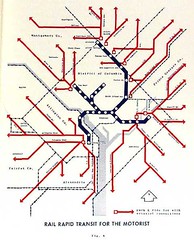Rail Rapid Transit for the (Suburban) Motorist
This is a map of the proposed subway system for the Washington region as of 1965, from an online exhibit by Zach Schrag, author of Great Society Subway about the creation of the subway system. And I have used this graphic once or twice or three times to illustrate the point, from the very beginning of planning the system, that it is oriented to the commuter from outside the city. (It just so happens that the density of stations at the core of the center city ended up benefiting the revitalization of center city neighborhoods, although it took a few decades.)
Steven calls our attention to a post by Rob Goodspeed, Metro's Fares Analyzed. Rob writes:
While most news reports have reported suburban riders would experience the largest absolute increases, my analysis shows they continue to enjoying the lowest cost per mile of all riders, well below the cost of automobile use.
He bases this on an analysis of the cost of a ride per mile. And he provides some graphs of his findings.
Relatedly, Sam Smith has written for many years that DC subsidized the suburbs from the very beginning of WMATA because the city put its fed. highway funds toward the construction, while MD and VA did not.
Further, I have written about Belmont's take (from the book Cities in Full about the subway system being suburban oriented--polycentric.

And I have written before that people have an incorrect sense of the concept of marginal cost when it comes to running a subway system. Adding riders during peak does cost much more, because the number of subway cars required to service riders during this time is greater than the average.
That isn't to say don't build the system to meet this demand. After all, DC's economic competitiveness is based upon the mobility benefits that the subway system provides.
It merely means that the marginal cost for service during peak periods is mostly higher compared to the average. So that peak charges are reasonable to assess from an economics perspective.
Labels: transit, transportation planning




0 Comments:
Post a Comment
<< Home